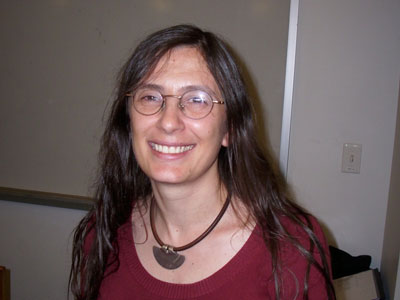The September 24 installment of the Department of Chemical Engineering Shell Seminar series, “Ices, Clathrates, and Quasicrystal: How Does Liquid Water Form Ordered Phases,” presented by Dr. Valeria Molinero of the University of Utah, was an exploration of the title topics. Conveniently for the listener, Molinero broke her talk into four distinct sections, each dealing with an aspect of her subject matter.
Molinero began by posing and answering the question, “What is essential to water physics?” The paradigm used in analyzing water for over 75 years has been that long-range forces, like Coulomb interactions, can be used to model short-range forces, like interactions. Molinero challenged this paradigm by suggesting and subsequently demonstrating that water can be accurately modeled using other tetrahedral elements, such as silicon. She also noted that this modeling is accurate with anomalous characteristics, such as super-cooled water behavior. These pieces of evidence led to her assertion, “Water behaves as if it were an element of the group 14, intermediate in the properties and tetrahedrality between carbon and silicon.” This segment allowed her to lay a foundation for the rest of the lecture by establishing her base assumptions, definitions, and models.
Having built a foundation, Molinero moved on to the first topic mentioned in her title – ice. She asked, “Is there any way to predict at what temperature water will become ice?” The rest of the section focused primarily on the fact that “the temperature at which the liquid must decide whether to go to ice or to glass is the same as the temperature of the liquid-liquid transformation” and what this means for predicting when water will become ice. She concluded the section by summarizing, “How does ice form? We see that it is linked to the formation of these low-density liquid domains…So what we conclude is that the temperature of homogenous nucleation… can be predicted by knowing the thermodynamic liquid transition of water,” and by explaining the practical applications of this knowledge.
Molinero continued through her outline by discussing quasicrystals. After a brief and amusing discourse on real snowflakes versus the depiction of snowflakes on Christmas cards, she narrowed in on her point about quasicrystals, which she defined as having very long-range order without having necessary components of normal crystals. Molinero presented observations about the one-dimensional, pentagonal composition of clathrate hydrates and new information on “wheels” – the first reported quasicrystal for any single component substance. The third segment of her presentation established that “confined water forms phases based on pentagons.”
Finally, Molinero discussed the last topic in the title – clathrates – by querying, “How does water nucleate crystals with insoluble guests?” She established the importance of clathrate hydrates (crystals of water that enclose small non-hydrogen bonding molecules) to energy and industry before moving on to the question of their formation. A few earlier philosophies on the origins of clathrates were suggested before Molinero submitted her own theory on a non-classical method for the origin of clathrates. First blobs are created through densification, then amorphous clathrates form from the ordering of water into cages, and finally, crystalline clathrates form through the ordering of methane. Molinero presented perhaps her most interesting ideas at the end of her discussion of clathrates.
Valeria Molinero’s lecture “Ices, Clathrates, and a Quasicrystal: How Does Liquid Water Form Ordered Phases,” part of the Department of Chemical Engineering’s Shell Seminar series, was interesting and informative. It was certainly not for the faint of heart or the non-chemical engineer, but it was a worthwhile learning experience.



'Shell Seminar covers liquid water’s formation of ordered phases' has no comments
Be the first to comment this post!